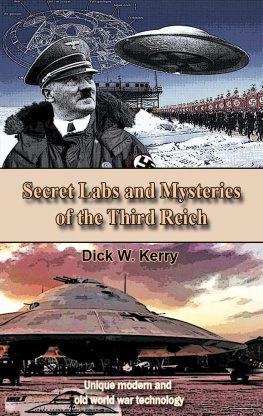William S. Carson - Secret Laboratories of Germany: Unique modern and old world war technology
Here you can read online William S. Carson - Secret Laboratories of Germany: Unique modern and old world war technology full text of the book (entire story) in english for free. Download pdf and epub, get meaning, cover and reviews about this ebook. year: 2020, genre: Religion. Description of the work, (preface) as well as reviews are available. Best literature library LitArk.com created for fans of good reading and offers a wide selection of genres:
Romance novel
Science fiction
Adventure
Detective
Science
History
Home and family
Prose
Art
Politics
Computer
Non-fiction
Religion
Business
Children
Humor
Choose a favorite category and find really read worthwhile books. Enjoy immersion in the world of imagination, feel the emotions of the characters or learn something new for yourself, make an fascinating discovery.

- Book:Secret Laboratories of Germany: Unique modern and old world war technology
- Author:
- Genre:
- Year:2020
- Rating:5 / 5
- Favourites:Add to favourites
- Your mark:
- 100
- 1
- 2
- 3
- 4
- 5
Secret Laboratories of Germany: Unique modern and old world war technology: summary, description and annotation
We offer to read an annotation, description, summary or preface (depends on what the author of the book "Secret Laboratories of Germany: Unique modern and old world war technology" wrote himself). If you haven't found the necessary information about the book — write in the comments, we will try to find it.
William S. Carson: author's other books
Who wrote Secret Laboratories of Germany: Unique modern and old world war technology? Find out the surname, the name of the author of the book and a list of all author's works by series.
Secret Laboratories of Germany: Unique modern and old world war technology — read online for free the complete book (whole text) full work
Below is the text of the book, divided by pages. System saving the place of the last page read, allows you to conveniently read the book "Secret Laboratories of Germany: Unique modern and old world war technology" online for free, without having to search again every time where you left off. Put a bookmark, and you can go to the page where you finished reading at any time.
Font size:
Interval:
Bookmark:
Secret Laboratories of Germany
Unique modern and old world war technology
William S. Carson
All rights reserved
William S. Carson, 2017
Fotos by:
Gina Smith
Tanya Dolski
Sam Sanderson
Bill Carson
This book is devoted to the secret laboratories of Nazi Germany. In this edition, you are waiting for underground laboratories and the first German nuclear weapons research.
The Third Reich concealed many mysteries. We will try to take a closer look at some of them.
Content:
Unfortunately, English is not the author's native language. All errors and inaccuracies in the book remain on his conscience.
Center for Nuclear Research in Gottow (Germany)

Today, it is an abandoned and forested area, with remains of mysterious reinforced concrete structures, lost in the German outback. And very few people know that it is here that humanity has persistently tried to tame the atom...
ATTENTION! The facility has traces of radioactive contamination, and apparently in the 1980s, attempts were made to deactivate it, however, there are fragments of uranium elements in the ground that create several foci of radioactive contamination.
As a result of a series of intrigues undertaken among German physicists, on October 10, 1942, as director of the physical institute of Kaiser Wilhelm, Heisenberg was appointed, who immediately came under the influence of the leading scientists of Germany's nuclear physics - Wirtz and Weizsacker. Having caught the moment, these "civilian" physicists found a way to exclude from work, "army" physicists in the person of Dr. Dibner, as a result of which, his research team, without any explanation, was transferred from the premises of the Berlin Institute, to the army testing center in Gottow.
The polygon in Gottow was designed to investigate explosives and was excellently equipped with high-class workshops and special boxes for exploring explosives.
Unfortunately, the plans and schemes of the research center have not been preserved, but all the structures of that period are practically accessible for inspection and study, and they are very well preserved. So, the center is a territory with an external perimeter of 2.67 km and an area of 0.4 km2, on which two parallel groups of structures are located, located from the east to the west and interconnected by rubbish.
The northern group is a series of eight T-shaped reinforced concrete stands, mainly intended for carrying out experiments with explosives. The dimensions of the main room of the stand are 43x12 m. All eight bench constructions have underground pass-through loss, allowing them to move between them, without leaving the surface. The extreme eastern stand of this group, often issued for the laboratory, is really equipped with a swimming pool, a pumping room and an air intake. In some publications, this place sometimes passes under the code "Viral wing" - in fact, such a statement is mistaken, the "Viral Wing" was the laboratory of another physicist, Karl Wirtz, who was in Berlin and occupied the corps of the Faculty of Biology, where before growing viruses. As for the group of Dibner, which operates on the territory of the center, according to available information, it occupied the last two buildings of the southern group of structures close to the location of the reactor.
The southern group is located 70 meters from the northern line, and it also contains eight buried buildings with a total casualty, which housed workshops and laboratories. The Southern and Northern Group, is also reported by three underground tunnels, which are currently flooded.
Reactor - From the western end of the southern group, there is a reactor building, which is a reinforced concrete basin, with dimensions of 3x3.5 meters, a depth of 3 meters and a wall thickness of 0.4 m. For a long time, among enthusiasts it was believed that the construction of a reactor, where Kurt Dibner, conducted several experiments with a subcritical reactor, was forever lost. In fact, it was simply not found, and in the end the opinion was consolidated that it was allegedly "blown up by the Russians". Luck in this area, waiting for us after declassifying the American documents of the mission "Alsos", they managed to find, the only available photo of the reactor, on which it was possible to unmistakably identify the foundation of the experimental basin.
However, we will return in October 1942, and we will consider in detail the historical significance of this place, in the context of the conquest of the atomic nucleus by mankind. So, having taken the original challenge, the group of Dibner, expelled from Berlin, without notifying Geisenberg, began own experiments in Gottow aimed at creating a nuclear boiler.
The first atomic boiler in Gottow The idea was a logical continuation of the Leipzig experiment, and was that Dibner suggested - alternations of uranium and moderator in three dimensions, probably will be more effective than the layered one (as in the Leipzig experiment). This led to the conclusion that the best form for a uranium element is not a flat plate of a .. -cube! By the way, the idea with the geometric configuration was really brilliant, but all this remains to be confirmed experimentally, and a little later, in the laboratories of Ezau, two other physicists - Pose and Rexser.
So, in Gott's center, for the first boiler, a special reinforced concrete reactor-reactor construction was built, and the company "Bamag-Beguin" made a cylindrical aluminum container in which it was planned to place an experimental nuclear boiler. While the reactor was assembling, a very ingenious method of layer-by-layer laying of paraffin and powdered uranium (uranium oxide) was developed. And, finally, when the work was completed, 6802 uranium cubes, 9.7 cm long, and a total weight of 25 tons, resting in paraffin honeycombs weighing about 4.5 tons, were placed in the boiler. The thickness of the paraffin partitions between the cells was 2 centimeters.
Before assembly, the container was installed in a reinforced concrete pool, and when everything was ready for the beginning of the experiment, the pool was filled with water, which served as a protection and reflector. In the thickness of the reactor, holes were drilled for introducing a source of neutrons and measuring equipment. Alas, the number of neutrons in the reactor did not increase, therefore, the first experiment could be considered conditionally unsuccessful. However, Dibner did not give up.

Only a month after the original expulsion of a group of "army" physicists from the premises of the Berlin Institute, through the Department of Armaments, Heisenberg received the first reports on the work carried out in Gottow, from which it became clear; Dibner is experimenting with the use of paraffin (as a moderator), powder and metal uranium. All three experiments were carried out with boilers in which only the thickness and number of layers differed. As a result, Dibner did not manage to even come close to the results obtained earlier in the Leipzig laboratory.
At the end of November 1943, at the National Bureau of Standards, a three-day secret conference took place, during which a number of reports were read out, including the report of the physicists Pose and Rexer I already mentioned, which confirmed experimentally that the best configuration for uranium elements is cube, and consequently, a group of physicists of Ezau, recommended immediately to begin the serial production of "uranium cubes". Luck was there, too, thanks to the fact that Auer Gezelschaft was able to find a method of phosphating the surface of uranium elements in time, Ezau and Dibner went to the board of Auer Gezelschaft, and agreed on the production of uranium cubes, without reducing the production of uranium plates. The firm went to meet them, and now, Dibner could start preparing the next two experiments with a nuclear boiler, in Gottow, the work again began to boil.
Next pageFont size:
Interval:
Bookmark:
Similar books «Secret Laboratories of Germany: Unique modern and old world war technology»
Look at similar books to Secret Laboratories of Germany: Unique modern and old world war technology. We have selected literature similar in name and meaning in the hope of providing readers with more options to find new, interesting, not yet read works.
Discussion, reviews of the book Secret Laboratories of Germany: Unique modern and old world war technology and just readers' own opinions. Leave your comments, write what you think about the work, its meaning or the main characters. Specify what exactly you liked and what you didn't like, and why you think so.




